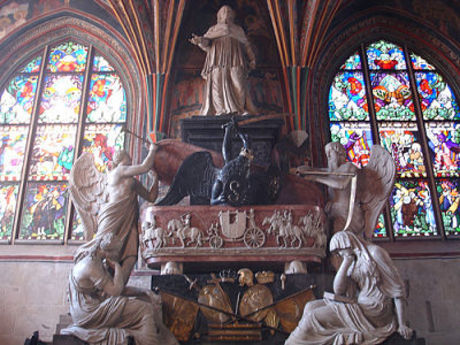Wawel Cathedral
The Wawel Cathedral, Katedra Wawelska in Polish, was the coronation site of Polish monarchs and remains Poland's most important national sanctuary. Thanks to its 1000-year-old history and numerous treasures the Krakow cathedral is arguably the most interesting place in the whole country, with the adjacent Wawel Royal Castle being the close second. Its present 14th-century walls shelter a great variety of top-class objects of art, from Gothic to Renaissance to Baroque to Classicist to Modern. It is also the burial ground of most Polish royalty as well as the greatest national heroes, two poets, four saints and countless Krakow bishops.
The center of the Wawel Cathedral's nave is occupied by the 1630 mausoleum of St. Stanislav, Poland's saint patron, the 11th-century Krakow bishop murdered by King Boleslav II (1058–1079). The martyr’s silver coffin (circa 1670) is adorned with 12 relief scenes from his life and posthumous miracles. Marble tombs of four 17th-century Krakow prelates accompany their saint predecessor's chapel-mausoleum.
Near the main entrance to cathedral, between pillars on the right side of the nave, there is an excellent 15th-century late-Gothic sarcophagus of King Vladislav II Jagiello (1386–1434) of red Hungarian marble. And on the left side it is mirrored by the 1906 good imitation of a Gothic sarcophagus by way of a symbolic tomb of King Vladislav III Warnenczyk (1434–1444) whose body wasn't found on the battlefield at Varna. At the end of the north aisle there is the mid-l4th-century sandstone sarcophagus, the cathedral’s oldest, of King Vladislav I the Short (1320–1333). His son, King Casimir III Great (1333–1370), has his tomb on the other side of the High Altar, across the nave, at the end of the south aisle. The late-l4th-century red marble sarcophagus ranks among Europe's best sculptures of the period. In the middle of the south aisle one finds the 1902 sarcophagus of Queen-Saint Jadwiga (1384–1399) carved in white Carrara marble with her grave insignia, wooden scepter and orb, displayed near by.
Eighteen chapels full of art treasures surround the Wawel Cathedral. Magnificent white “pearl of the Renaissance" vis-a-vis the tomb of Queen Jadwiga, the Sigismund Chapel, couples the exquisite Baroque of the black marble Vasa Chapel. The Chapel of the Holy Cross (first to the right on entrance) seems most interesting owing to its 1470 Russian murals and the splendid 1492 marble sarcophagus of King Casimir IV Jagiello (1447–1492) by Veit Stoss. The chapel also boasts two outstanding late-Gothic triptychs by 15th-century Krakow painters, the imposing 1789 late-Baroque tomb of Bishop Soltyk, and fine stained-glass widows of the turn of the 20th century.




